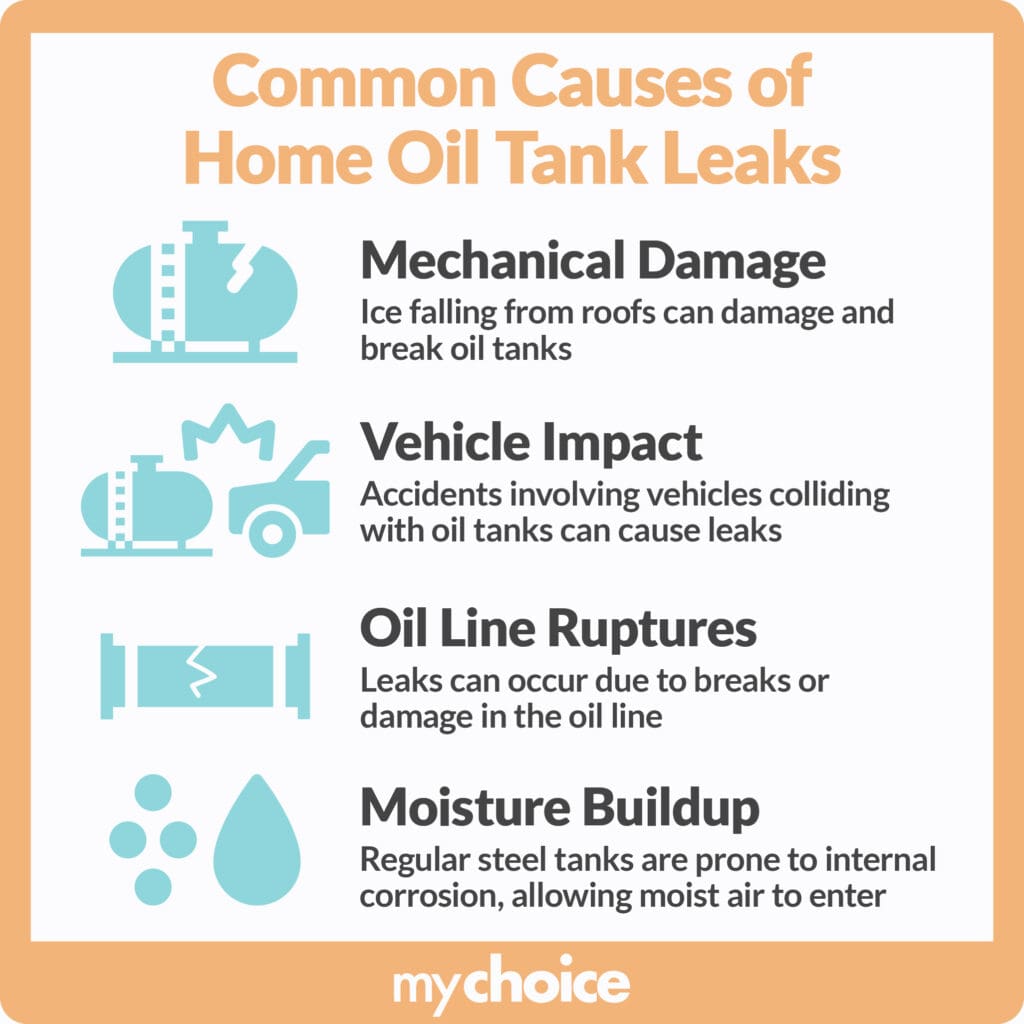Unfortunately, your home insurance may not cover oil tank leaks. These days, you’ll be hard-pressed to find an insurer that covers it. However, some insurance companies may offer an endorsement that covers oil leaks for an additional cost.
Read on to discover why oil tanks can be a major liability and what you can do to protect yourself if you own one.
Like Oil and Water: Why Oil Tanks and Home Insurance Don’t Mix
Before natural gas became prevalent in Canadian homes, most people used oil to fuel their heating systems. Oil was stored in one of three ways:
- Above-ground outdoor tanks: Medium capacity tanks that can be found next to the house; often exposed to the elements;
- Underground tanks: Larger capacity tanks that are buried beneath soil; can be difficult to find and remove;
- Indoor tanks: Smaller capacity tanks that are kept in utility rooms, basements, and garages.
Eventually, oil tanks fell out of favour due to the volatility of oil prices, the availability of natural gas and other heating alternatives, and the risks involved with oil leaks.
When an oil tank leaks, it can damage your soil and property and pose serious health and safety risks. The cost to repair and remedy any damages caused by an oil leak can set you back hundreds of thousands of dollars. To be exact, the average estimate for remediating damages caused by home oil tank leaks is about $250,000 to $500,000.
And therein lies the rub. Unlike water leaks and natural gas leaks, which are typically covered by most home insurance policies, oil tank leaks are not usually covered. For many home insurance companies, oil tanks are simply too risky to insure. Some providers will even flat-out refuse to provide coverage for properties with oil tanks, especially if the tank is over 20 years old.
How Can I Get Coverage for an Oil Tank?
Some insurance providers offer an “Escape of Fuel Oil” endorsement that homeowners can add to their policy for an added rate. This add-on covers:
- Direct damage to property covered by the policy
- The cost of cleaning and decontaminating soil (up to a maximum of $150,000)
- The cost of replacing certain plants
- Civil liability (up to a maximum of $150,000)
Oftentimes, this type of endorsement does not cover the tank, pipes, or apparatus that caused the damage but only damage done to the property and its contents. This endorsement does not usually cover any efforts to remedy environmental damage like groundwater contamination either.
Here are some other stipulations you must meet to be eligible for coverage:
- The oil tank must not be over 20 years old
- All components of the storage tank system must carry a certification mark showing that they meet regulation standards
- Tanks must be double-walled with an inner plastic liner and solid concrete pad
- The tank must be bolted down to prevent potential damage during earthquakes
Another thing you can do is apply for high-risk insurance, a type of policy geared toward properties that are deemed riskier to insure than others, such as heritage homes, vacant dwellings, and houses with older plumbing, electrical, and heating systems.
Problems Caused By Oil Leaks
These are the main reasons why most insurance companies and real estate agents often want nothing to do with oil tanks:
How to Prevent an Oil Tank Leak?
If you plan on moving into a home with an existing oil tank, keep the following tips in mind to prevent leaks:

Understanding Regulations on Oil Tanks
The Technical Standards and Safety Authority (TSSA) regulates the “transportation, storage, handling, and utilization” of fuels in Ontario, such as natural gas, hydrogen, propane, butane, gasoline, diesel, and fuel oil. Some of the regulations imposed on oil tanks by the TSSA include:
- Before oil tanks are used, filled, maintained, or removed, they must be registered and assigned a unique registration number.
- Underground oil tanks that have not been in use for over two years must be removed to reduce the risk of environmental damage from oil leaks.
- Oil tanks older than 25 years old must also be removed. If you don’t know the age of your tank, the TSSA expects you to assume the tank is past its removal age.
- Oil tanks must be removed by a TSSA-registered fuel oil contractor.
- If a leak occurs during the removal process, you must contact the Spill Action Center of the Ministry of Environment.
On top of this, underground and aboveground storage tank systems are also required to have:
- Corrosion protection
- Spill containment
- Containment sumps (if applicable)
- Liquid- and vapour-tight connections
- Overfill protection
- Secondary containment for aboveground tanks
- Double-walled for underground tanks
Key Advice From MyChoice
- Most insurers won’t provide coverage for oil tank leaks.
- Some insurers may offer a special endorsement that covers “Escape of Fuel Oil” for an additional rate.
- Oil tank leaks are preventable with proper maintenance and by following the standards set by the TSSA.
- Before buying a house, make sure you get a home appraisal to assess whether the home has an existing oil tank and figure out the potential costs of removing and/or maintaining it.








